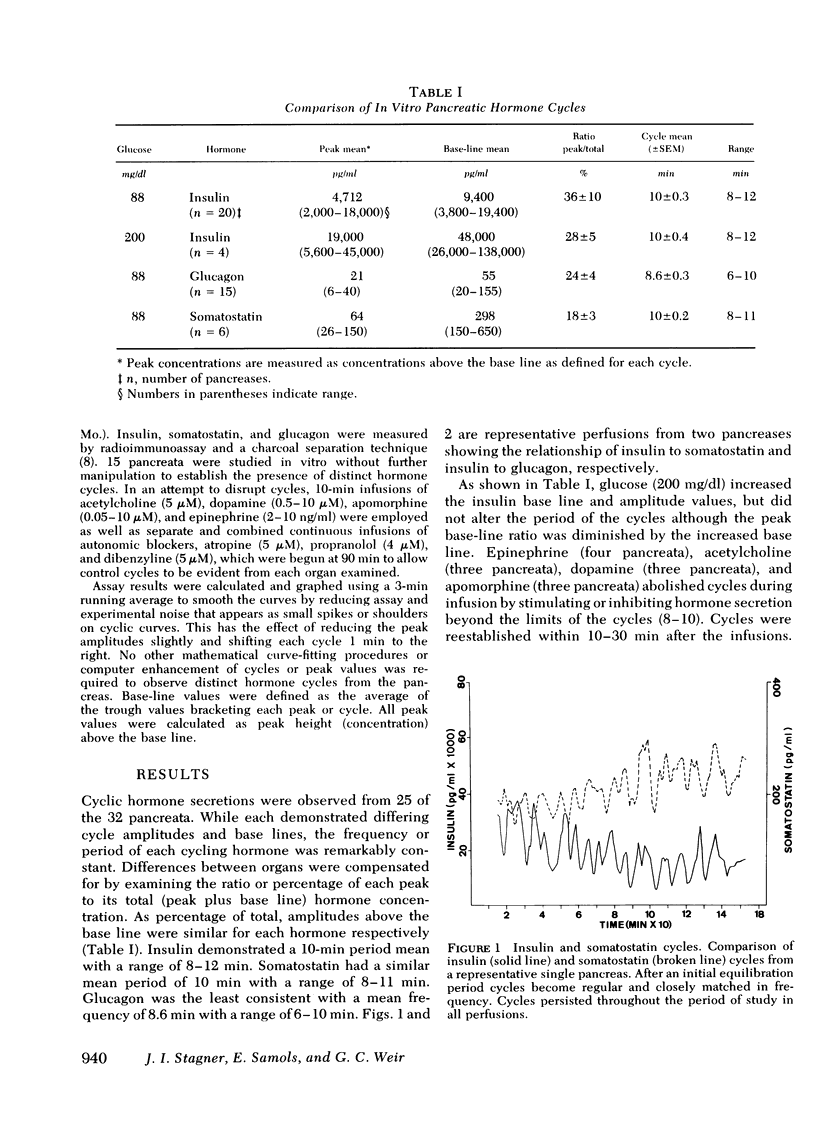Abstract
Canine pancreata were perfused in vitro to examine whether hormone cycles could be demonstrated without hepatic or central nervous influence. Insulin, glucagon, and somatostatin demonstrated regular sustained cyclic secretion from the in vitro canine pancreas. Oscillations were noted for over 200 min during the infusion of a constant glucose concentration. Insulin demonstrated a 10-min period with a range of 8-12 min/cycle. Somatostatin had a 10-min period with a range of 8-11 min. Glucagon had a period of 8.6 min with range of 6-10 min. These periods do not allow glucagon to be consistently 90° out of phase with insulin and somatostatin.
When glucose was increased from 88 to 200 mg/dl, insulin cycles persisted but on an elevated base line, demonstrating that cycles react to glucose changes but are not dependent upon them. Cycles were disrupted by infusions of dopamine, apomorphine, epinephrine, and acetylcholine, but were reestablished. Autonomic blockade by both single and combined infusions of atropine (cholinergic), propranolol, and dibenzyline (adrenergic) had no effect on cycles. These results suggest that, in vitro, there is an intrinsic rhythm of hormone secretion by the pancreas despite a constant glucose level. The production of in vitro cycles requires the presence of a driving oscillator or pacemaker within the pancreas and the coordination of islets by pace-maker-islet communication, presumably by a non-adrenergic neural system. In vitro oscillations may Indicate that the pancreas is the driver or Zeitgeber of in vivo glucose-insulin cycles.
Full text
PDF



Selected References
These references are in PubMed. This may not be the complete list of references from this article.
- Goodner C. J., Walike B. C., Koerker D. J., Ensinck J. W., Brown A. C., Chideckel E. W., Palmer J., Kalnasy L. Insulin, glucagon, and glucose exhibit synchronous, sustained oscillations in fasting monkeys. Science. 1977 Jan 14;195(4274):177–179. doi: 10.1126/science.401543. [DOI] [PubMed] [Google Scholar]
- Hermansen K., Christensen S. E., Orskov H. Characterisation of somatostatin release from the pancreas: the role of calcium and acetylcholine. Diabetologia. 1979 Apr;16(4):261–266. doi: 10.1007/BF01221953. [DOI] [PubMed] [Google Scholar]
- Iversen J., Miles D. W. Evidence for a feedback inhibition of insulin on insulin secretion in the isolated, perfused canine pancreas. Diabetes. 1971 Jan;20(1):1–9. doi: 10.2337/diab.20.1.1. [DOI] [PubMed] [Google Scholar]
- Lang D. A., Matthews D. R., Peto J., Turner R. C. Cyclic oscillations of basal plasma glucose and insulin concentrations in human beings. N Engl J Med. 1979 Nov 8;301(19):1023–1027. doi: 10.1056/NEJM197911083011903. [DOI] [PubMed] [Google Scholar]
- Larsson L. I., Rehfeld J. F. Peptidergic and adrenergic innervation of pancreatic ganglia. Scand J Gastroenterol. 1979;14(4):433–437. [PubMed] [Google Scholar]
- Malaisse W. J., Sener A., Herchuelz A., Hutton J. C. Insulin release: the fuel hypothesis. Metabolism. 1979 Apr;28(4):373–386. doi: 10.1016/0026-0495(79)90111-2. [DOI] [PubMed] [Google Scholar]
- Saccà L., Cryer P. E., Sherwin R. S. Blood glucose regulates the effects of insulin and counterregulatory hormones on glucose production in vivo. Diabetes. 1979 Jun;28(6):533–536. doi: 10.2337/diab.28.6.533. [DOI] [PubMed] [Google Scholar]
- Samols E., Harrison J. Intraislet negative insulin-glucagon feedback. Metabolism. 1976 Nov;25(11 Suppl 1):1443–1447. doi: 10.1016/s0026-0495(76)80161-8. [DOI] [PubMed] [Google Scholar]
- Samols E., Weir G. C. Adrenergic modulation of pancreatic A, B, and D cells alpha-Adrenergic suppression and beta-adrenergic stimulation of somatostatin secretion, alpha-adrenergic stimulation of glucagon secretion in the perfused dog pancreas. J Clin Invest. 1979 Feb;63(2):230–238. doi: 10.1172/JCI109294. [DOI] [PMC free article] [PubMed] [Google Scholar]


